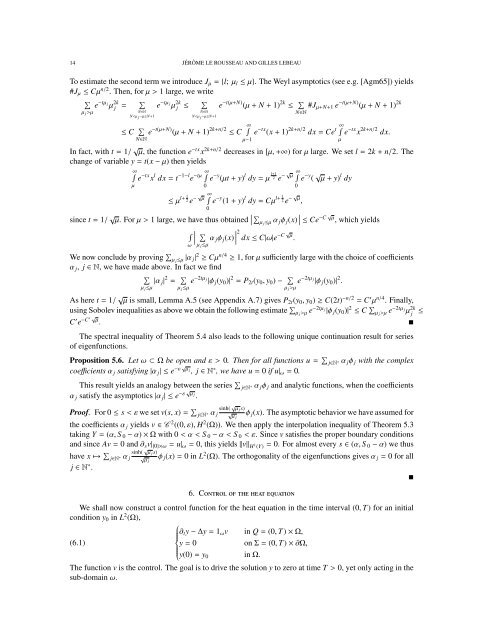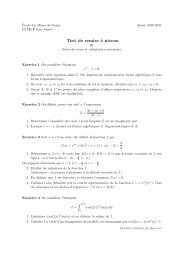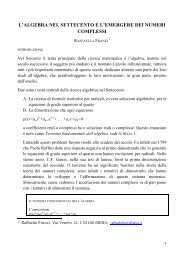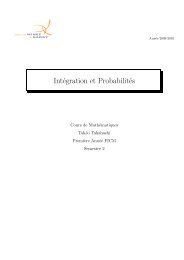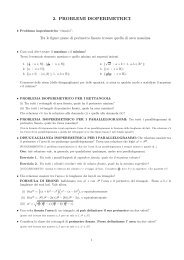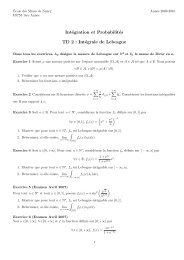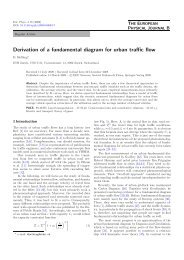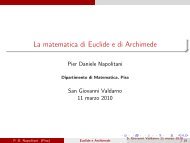on carleman estimates for elliptic and parabolic operators ...
on carleman estimates for elliptic and parabolic operators ...
on carleman estimates for elliptic and parabolic operators ...
Create successful ePaper yourself
Turn your PDF publications into a flip-book with our unique Google optimized e-Paper software.
14 JÉRÔME LE ROUSSEAU AND GILLES LEBEAU<br />
To estimate the sec<strong>on</strong>d term we introduce J µ = {l; µ l ≤ µ}. The Weyl asymptotics (see e.g. [Agm65]) yields<br />
#J µ ≤ Cµ n/2 . Then, <strong>for</strong> µ > 1 large, we write<br />
∑<br />
e −tµ j<br />
µ 2k ∑<br />
j = e −tµ j<br />
µ 2k ∑<br />
j ≤ e −t(µ+N) (µ + N + 1) 2k ≤ ∑ #J µ+N+1 e −t(µ+N) (µ + N + 1) 2k<br />
µ j >µ<br />
N∈N<br />
Nµ e −2tµ j<br />
|φ j (y 0 )| 2 ≤ C ∑ µ j >µ e −2tµ j<br />
µ 2k<br />
j<br />
≤<br />
C ′ e √µ −C′ .<br />
<br />
The spectral inequality of Theorem 5.4 also leads to the following unique c<strong>on</strong>tinuati<strong>on</strong> result <strong>for</strong> series<br />
of eigenfuncti<strong>on</strong>s.<br />
Propositi<strong>on</strong> 5.6. Let ω ⊂ Ω be open <strong>and</strong> ε > 0. Then <strong>for</strong> all functi<strong>on</strong>s u = ∑ j∈N ∗ α jφ j with the complex<br />
coefficients α j satisfying |α j | ≤ e −ε √ µ j<br />
, j ∈ N ∗ , we have u = 0 if u| ω = 0.<br />
This result yields an analogy between the series ∑ j∈N ∗ α jφ j <strong>and</strong> analytic functi<strong>on</strong>s, when the coefficients<br />
α j satisfy the asymptotics |α j | ≤ e −ε √ µ j<br />
.<br />
Proof. For 0 ≤ s < ε we set v(s, x) = ∑ j∈N α sinh( √ µ j s)<br />
∗ j √ µ j<br />
φ j (x). The asymptotic behavior we have assumed <strong>for</strong><br />
the coefficients α j yields v ∈ C 2 ((0, ε), H 2 (Ω)). We then apply the interpolati<strong>on</strong> inequality of Theorem 5.3<br />
taking Y = (α, S 0 − α) × Ω with 0 < α < S 0 − α < S 0 < ε. Since v satisfies the proper boundary c<strong>on</strong>diti<strong>on</strong>s<br />
<strong>and</strong> since Av = 0 <strong>and</strong> ∂ s v| {0}×ω = u| ω = 0, this yields ‖v‖ H 1 (Y) = 0. For almost every s ∈ (α, S 0 − α) we thus<br />
have x ↦→ ∑ j∈N α sinh( √ µ j s)<br />
∗ j √ µ j<br />
φ j (x) = 0 in L 2 (Ω). The orthog<strong>on</strong>ality of the eigenfuncti<strong>on</strong>s gives α j = 0 <strong>for</strong> all<br />
j ∈ N ∗ .<br />
<br />
µ j >µ<br />
6. CONTROL OF THE HEAT EQUATION<br />
We shall now c<strong>on</strong>struct a c<strong>on</strong>trol functi<strong>on</strong> <strong>for</strong> the heat equati<strong>on</strong> in the time interval (0, T) <strong>for</strong> an initial<br />
c<strong>on</strong>diti<strong>on</strong> y 0 in L 2 (Ω),<br />
⎧<br />
∂ t y − ∆y = 1 ω v in Q = (0, T) × Ω,<br />
⎪⎨<br />
(6.1)<br />
y = 0<br />
<strong>on</strong> Σ = (0, T) × ∂Ω,<br />
⎪⎩ y(0) = y 0 in Ω.<br />
The functi<strong>on</strong> v is the c<strong>on</strong>trol. The goal is to drive the soluti<strong>on</strong> y to zero at time T > 0, yet <strong>on</strong>ly acting in the<br />
sub-domain ω.


